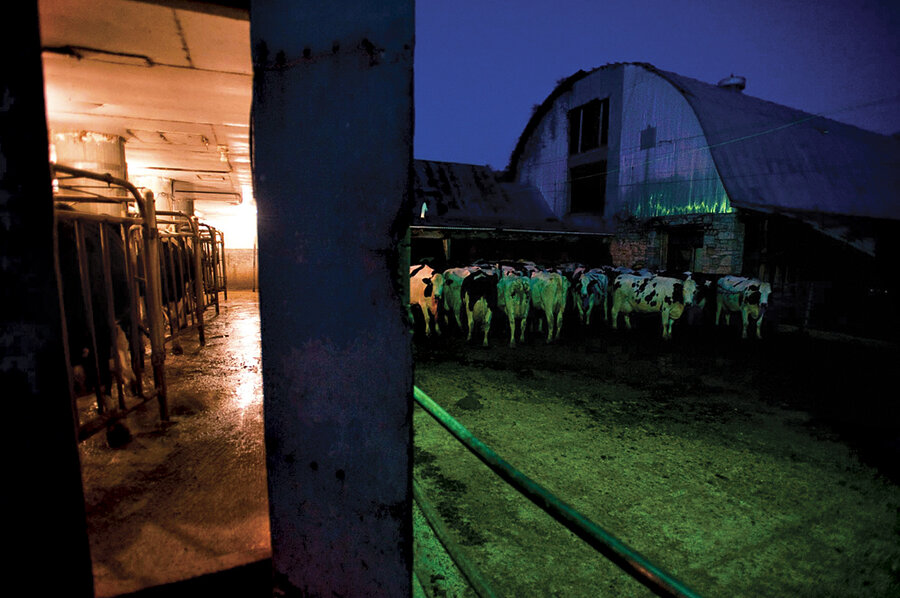Dairy farm chronicles
Loading...
When I read of James Herriot's death on Feb. 23, 1994, I put aside chores for a time and paid my respects. Among the daily notations of calvings, cows in heat, breedings, and milk weights, a more carefully penned "Farewell James Herriot" fills in one wintry space of that year's milk-room calendar.
It felt like the right place to remember the Yorkshire vet who tended animals on small farms like ours before and after becoming a popular author. The calendar – a safe, accessible repository for the all-important details and noteworthy events connected to running our dairy – had presence. It hung out of splash range of the sinks, just above the countertop where we set gloves and coffee cups.
It was impossible not to look over the month on display, and hard to resist flipping back to previous months as I breakfasted. The color photos of broad-muscled Belgians, Percherons, Suffolks, and shires at their seasonal labors (we used the Draft Horse Calendar from Mischka Farm in Whitewater, Wis.) seemed to prime us for the day's work, especially if it involved our own draft animals.
The large date squares on this calendar allowed several brief daily entries. The milk shipment, in pounds, occupied the lower right corner, leaving ample space for other jottings. One April 1, for example, was triply notable: "Gwen's birthday," "potatoes and onions in," and "Red is bred." A single run-on sentence sprawled across Nov. 25 and 26 of that year: "Geese moving in wave after wave, what a beautiful sight!"
Most annual, seasonal, or singular events that captured our attention found their place on the calendar. The spring arrival of the cowbirds, swifts, orioles, and swallows; October's first snow flurry; sandhill cranes alighting to rest; a favorite cow's new heifer; my son's first day in grammar school; a beloved author's passing in a small North England town.
We saved the calendars from past years. Trends pop out – good years and bad – as we gradually moved near the break-even point with our small, low-input operation. Different months took on distinct personalities. January in Indiana is a quiet month of unpredictable weathers. Its most dependable element was Jezibel, a small brown Jersey who obstinately calved in the opening days of the New Year, whatever the weather, and preferably out in it.
By February we began recording harvests from the sugar maples and the cows simultaneously on the calendar. The days flowed by on gallons of sap and pounds of milk.
In March, we began to think of the gardens and heavy work to come. "Chicks hatch" on the 9th of one year, replacing some of the laying hens we'd lost over the winter. "Geese and crane" canopy across the farm, pushing north, and we "change the oil and filters on the tractors."
By April we were up and running. We "plow the gardens" and, one spring day "plant clover, timothy, and lespedeza." The "redstart returns" on April 26 that year, after a six-year absence. The "barn swallows arrive," patching their old nests. In the latter part of the month, we began to find morel mushrooms. And, of course, sometime in April "Jezibel is bred."
The morel sometimes lingered into May, when haying began. One year, we noted three breedings in quick succession that month. On the 28th, as the bull rested, the "kingbird returned."
The high summer months bear few entries unrelated in some way to haying or rain, the one break from cutting, raking, baling, and stacking.
Each year the "swallows leave" in August, and Tim began another school year.
As September passed, the last cuttings were raked and baled, and the barn loft is filled to capacity. "Found ginseng" spoke of a leisure rarely enjoyed in the summer.
Things quickened in October, a month of almost electric expectancy for us. On Oct. 26, 1992, we completed the stone chimney and fireplace for the log cabin we'd built among the sugar maples, and on the 16th lit the first fire in our new hearth. "Doc and Jim arrive" on Oct. 14, 1993, stepping with ponderous feet from trailer to pasture and ushering in a new era on the farm. The geese again arched overhead, moving south. The "last monarch" left and the "first snow" sifted mutely down among the brilliant leaves.
Geese sightings multiplied in November. We marked their annual passing on the calendar on and around the day "fall taxes are due."
Time slowed in December, whose calendar entries chronicled late migrating geese; one day carried a reminder to "reorder calendar." There were the usual records of milk weights and calvings. But no month was entirely routine. On Dec. 15, 1993, Charlie penned in flourishing letters, "Farm paid in full," surely the signal entry of the decade. We celebrated Christmas that year with a special sense of grace, our 80 acres beautiful, and, the calendar noted, enveloped in "snow."





